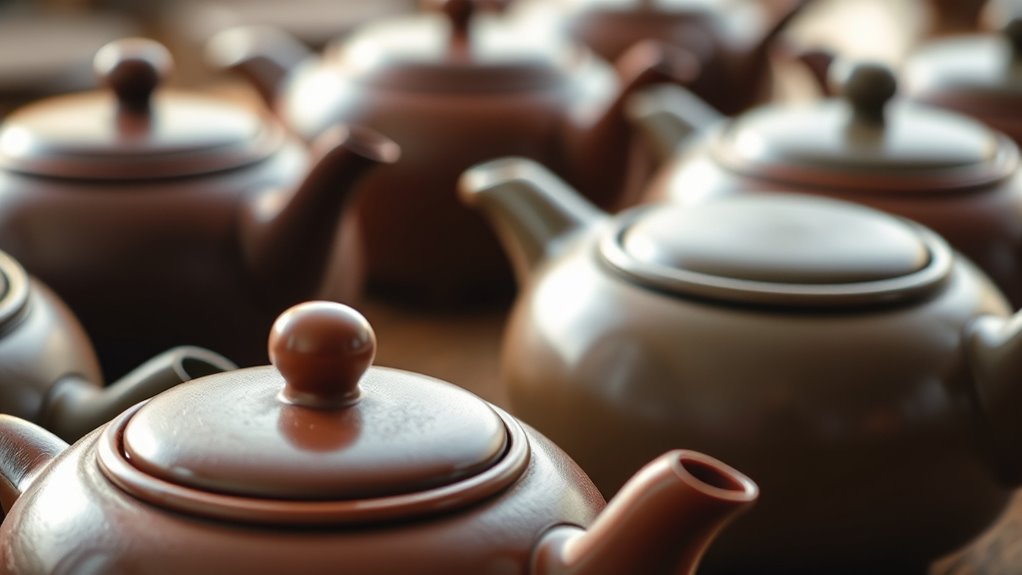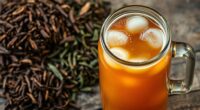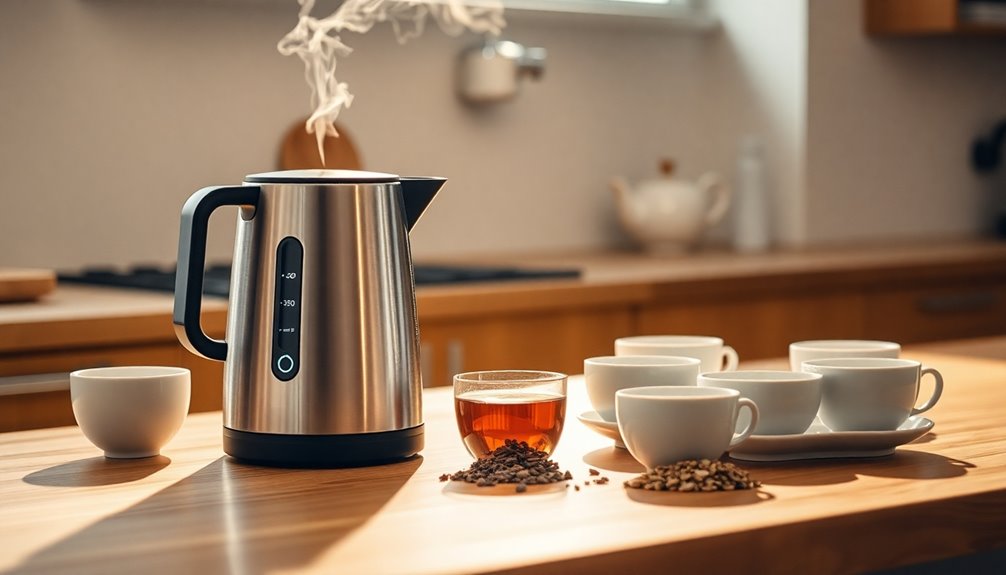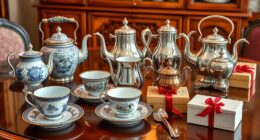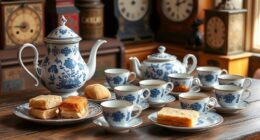A beginner’s guide to Japanese kyusu pots shows you how these traditional teapots are perfect for brewing green teas like sencha and gyokuro. Designed with a wide, flat shape and built-in strainer, they allow for quick, even steeping and easy pouring. To keep your kyusu in great shape, rinse it with warm water after each use and dry thoroughly. Continuing will help you discover simple tips to enhance your brewing skills and enjoy authentic Japanese tea.
Key Takeaways
- Kyusu is a traditional Japanese teapot designed for brewing green teas like sencha and gyokuro.
- Its wide, flat shape promotes quick, even steeping and features a built-in strainer for easy pouring.
- Proper cleaning involves rinsing with warm water without soap to preserve flavor and prevent contamination.
- Preheating the kyusu and pouring promptly helps avoid over-steeping and bitterness.
- Regular maintenance builds a seasoned patina that enhances flavor and ensures long-lasting use.
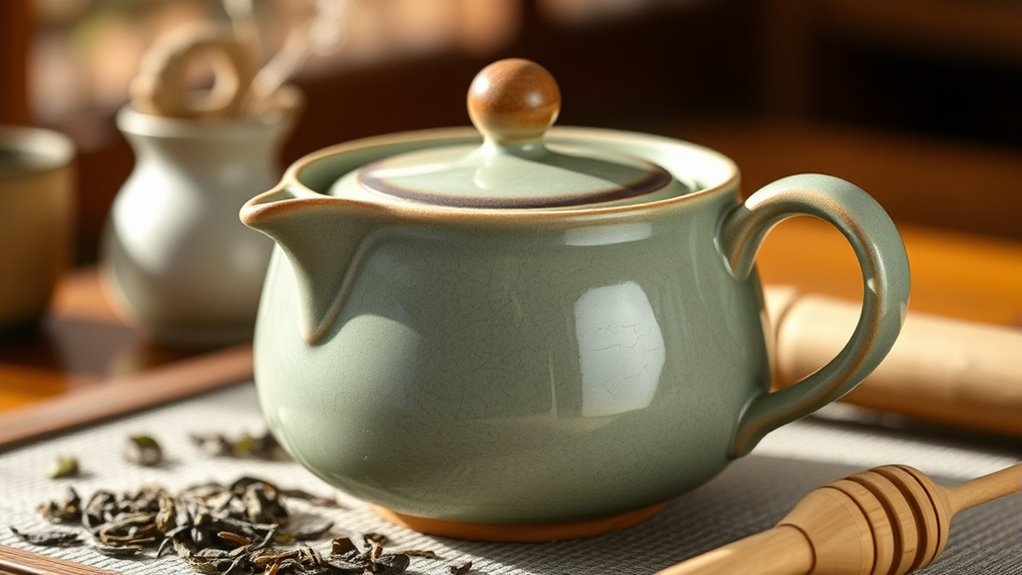
If you’re new to Japanese tea culture, learning about kyusu pots is a great place to start. These traditional teapots are designed specifically for brewing Japanese green teas like sencha, gyokuro, and bancha. Using a kyusu can elevate your tea-drinking experience, but it also requires some understanding of tea brewing and pot maintenance. As a beginner, you’ll want to focus on how to brew your tea properly and care for your kyusu so it lasts long and continues to perform well.
When it comes to tea brewing, the design of the kyusu makes a difference. Its wide, flat shape allows for quick and even steeping, helping you extract the best flavors from your tea leaves. You’ll want to pay attention to water temperature and steeping time, as these are vital for achieving the perfect flavor. Since kyusu pots often have a built-in strainer, you can pour directly from the spout without worrying about loose leaves slipping into your cup. This makes the process simple and clean. To get the best taste, preheat your kyusu with warm water before adding your tea leaves. This step guarantees your tea brews evenly and maintains the proper temperature. After brewing, pouring the tea promptly prevents over-steeping, which can turn the tea bitter. With practice, you’ll learn how much tea and water to use for your preferred strength, making each cup tailored to your taste. Additionally, understanding tea brewing techniques can significantly enhance your overall experience.
Pot maintenance is just as important as the brewing process. Proper care guarantees your kyusu remains in good condition and continues to deliver flavorful tea. Most kyusu are made from clay, which absorbs flavors over time, enhancing future brews but also requiring gentle handling. After each use, rinse the pot with warm water—avoid soap, as it can linger and affect the taste of future teas. Never scrub the interior vigorously; instead, let the water loosen any residual leaves or stains. If you notice mineral deposits or stubborn stains, a gentle brush can help, but avoid harsh abrasives. Dry the kyusu thoroughly, especially around the spout and lid, to prevent mold or mold-like spots. Regularly inspecting your pot for cracks or chips is also wise, as damaged clay can harbor bacteria or leak. With consistent, careful maintenance, your kyusu will develop a seasoned patina that enhances the flavor of your teas over time.
Mastering tea brewing and pot maintenance with your kyusu will deepen your appreciation for Japanese tea culture. It’s not just about making a good cup; it’s about respecting the tradition and nurturing your teapot so it can serve you well for years. As you gain experience, you’ll notice subtle improvements in your brewing and handling, making each cup a more satisfying and authentic experience.
Frequently Asked Questions
Can Kyusu Pots Be Used for Brewing Coffee?
You can use kyusu pots for coffee brewing, but they’re primarily designed for tea infusion. Since kyusu pots are made for delicate tea leaves, they might not handle strong coffee grounds well. If you decide to try, ensure you dedicate a kyusu for coffee to avoid cross-flavor contamination. It’s a unique way to enjoy coffee, but for ideal results, a dedicated coffee maker is usually better.
What Is the Ideal Tea Type for a Kyusu?
You should choose delicate, green or white tea leaves for your kyusu, as they highlight its fine craftsmanship. Use a brewing temperature around 70-80°C to avoid bitterness and bring out the tea’s nuanced flavors. The kyusu’s design makes it perfect for single, short infusions, so select tea leaves that release their aroma quickly. With proper tea leaf selection and precise temperature control, you’ll enjoy a truly authentic Japanese tea experience.
How Do I Clean and Maintain My Kyusu?
Cleaning your kyusu is like tending a delicate garden—you need gentle care. To remove tea stains, rinse with warm water immediately after use, avoiding soap that might affect flavor. For stubborn stains, use a soft brush or a mixture of baking soda and water. Seasoning tips include avoiding dishwashers and occasional dry burning to maintain the pot’s seasoning. Regular cleaning keeps your kyusu vibrant and flavorful for years.
Are There Different Materials Used for Kyusu Pots?
You’ll find kyusu pots made from various ceramic varieties like porcelain, clay, and even glazed options, each offering unique benefits for taste and heat retention. Metal options, such as stainless steel or cast iron, are also available, providing durability and modern aesthetics. When choosing, consider your brewing style and maintenance preferences. Different materials impact how your tea tastes and how easy the pot is to clean, so pick the one that suits you best.
Can Kyusu Pots Be Used on Induction Stovetops?
Imagine brewing tea as a ritual, but your kyusu pot meets an obstacle—induction compatibility. Not all kyusu pots are suitable for induction stovetops; it depends on the material. If your pot is made of cast iron or has a magnetic stainless steel base, it should work well. However, traditional clay or ceramic kyusu might not be compatible, so always check material considerations before using on an induction stove.
Conclusion
So, after all this talk about delicate teapots, you’d think brewing Japanese tea is some secret art reserved for experts. But here’s the irony: with a kyusu in hand, you’re already closer than most to mastering it. No fancy gadgets, no complicated techniques—just a simple pot and a little patience. So go ahead, embrace the tradition, and enjoy every sip. Turns out, the secret to great tea is just a tiny pot and a big smile.

